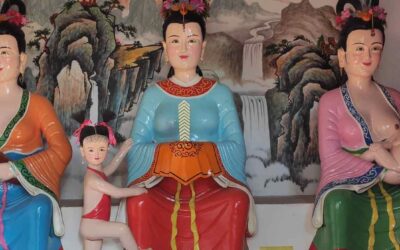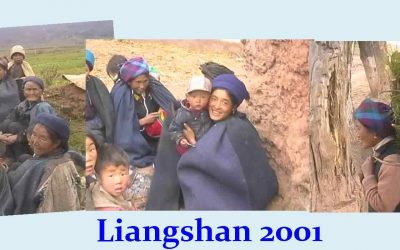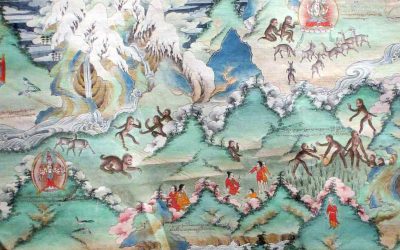Midnight by Mao Dun – a failed novel
Before reading «Midnight», the masterpiece of Mao Dun, the most powerful Chinese writer in the twentieth century, reading the presentations of the Chinese edition, one wonders why such a great literary treasure is not better known outside China. After reading it, one discovers that its literary value is not so great, and that it is far from being one of the best Chinese novels of the 20th century.
The novel Midnight is considered a realist work and is part of the movement of new Chinese literature. In fact, the realism is very soft because despite being set in both the power struggles between the industrial economic tycoons of Shanghai and the social conflicts between factory owners and workers, the development is quite superficial. Nor does the depiction of these contradictions go as far as to overload the ink at any point, not even looking for a realism that could be true. For example, when describing the tremendous strike in the factory of the protagonist Wu Sunfu, the police put some of the communists or suspects of being communists in a room but we are not seeing the tortures or murders that occurred with some frequency at that time. And even the conflicts between the two big financial sharks still seem to be kept in what we might call a civilized situation. Their attempts to influence government policies are blurred in obscure words, money is not seen, nor is violence, in short, the ills of society that realism presumes to show in the light are not present in this novel.
But to consider this work as realistic is not a mere play on words, it is important in the reader’s interest in knowing what the situations described by the author were really like, and which unfortunately remain unknown. For example, both the description of the workers’ huts, where much of the action takes place in the strike chapters, and the workers’ motives for living there instead of in their native places are treated with a superficiality that makes it difficult for the reader to empathize. There are a couple of glimpses, it is true, that is, the reader knows that they are practically shantytowns but there is no idea of how life goes on in them. Nor does the author decide to tell the story of any of these people, and that I think is a mistake because without the individualization of the characters that provides their personal history, the reader does not find an empathy that allows him to understand them, to love them, to be interested in what happens to them.
It would have given another color to the novel to provide a description of the arrival in Shanghai of its protagonists. This description would not have detracted from the interest of the novel, because in just a couple of pages it could have been quite clear the panorama of insecurity, hunger, violence, loan sharking, etc., in which they were living and that could make one understand that such a miserable life could be worthwhile for them. On the contrary, by starting the novel describing the life of the great industrialists, he is encouraging us to identify with them. The reader feels closer to the small problems of the young aristocrats than to the great tragedies of the union activists. And that is a pity because the author knows how to do it, as he demonstrates in the short stories and novellas translated in «Spring Silkworms and other stories» (Foreign Language Press, Beijing, 1979).
And it is not that I expected a more revolutionary work, it is that I miss the full understanding of the problems he raises. It is to be appreciated that the author does not fall into the Manichaeism of good guys and bad guys, and in fact shows us how the economic reality faced by industrialists is quite complex, with a series of government policies that facilitate the entry of foreign products almost without taxes, while taxing Chinese products, with an almost continuous state of war that hinders trade and communication with the interior of the country, with a series of multinational companies, with greater capital and technology competing for an ever-shrinking market, and the ever-present temptation of speculation with government bonds that appear as their salvation.
I say this because the author does allow us to understand the behavior of most of the wealthy characters. He gives us the clues, he tells us how they got their fortune and why they moved to Shanghai, he even tells us about the problems they faced when they arrived in the city. But we don’t know any of this about the workers’ characters, and this, for a novel that tries to realistically depict 1930s Shanghai, is a major flaw. The great fresco that is intended to be of the reflection of life in the city remains blurred.
In the end, without knowing the emotions that animate the stereotyped characters of the workers, without knowing what is at stake with every move, it is not possible to place them clearly in that fresco, while on the other hand, the meticulous description of each of the small financial victories and defeats of the protagonists, which one suspects will not have really tragic consequences, becomes repetitive in a work of more than 500 pages. In the end, what promised to be the great novel of the city remains a description of the last two months of Wu Sunfu’s financial career, and we don’t even know enough about him to know how he got to where he is.
A failed novel, despite the fact that the Chinese editors claim that «it is considered his masterpiece» and that «it was well received by the public. Qu Qiubai, a respected literary critic, called it «the first successful novel of Chinese realism» and noted that the author «has succeeded in literarily expressing the relationships prevailing in the society of the time, applying authentic social sciences».
The author, born Chen Yanbing (1896-1981) in the province of Zhejiang, was one of the key figures in the cultural and literary world of China, from November 1920, when he founded with other authors the Literary Research Society, until his death 6 decades later. He was director of political and literary publications, delegate to the National People’s Congress after the founding of the People’s Republic of China, president of important literary associations, director of the magazine Chinese Literature, and Minister of Culture.
Cite this article as: Ceinos-Arcones, Pedro, «The first description of the Religion of the Yi,» in Ethnic China, 21 marzo 2021, https://ethnic-china.com/the-first-description-of-the-religion-of-the-yi/.
Last posts
The Local Lords cult of the Bai nationality
The worship of the Local Lords (benzhu) is the most characteristic of the Bai people. Their religious life revolves around the Benzhu temple of each village, as each village venerates a local lord, sometimes a historical figure who sacrificed for the people. In other...
The tiger hero of the Naxi
The tiger hero of the Naxi[1] A long time ago, a man named Gaoqu Gaobo lived in the Baoshan area. He had a strong body, lively intelligence, and certain magical powers. He was always willing to help people. One day he went on a trip with a group of villagers. After a...
Wonderful- yaks most precious treasure is their manure
Wonderful- yaks most precious treasure is their manure Most of the travelers who visited Tibet in former times noticed the importance that, for the maintenance of the living of the Tibetan nomads and travellers, had the Yak manure, known among the...
Life of Milarepa, the hermit poet
Life of Milarepa, the hermit poet. MiIarepa is one of the most beloved religious leaders of Tibet. His story, full of unique facts, has been told again and again over the centuries, and if the publishers did not warn that this is the autobiography written by the holy...
The first description of the Religion of the Yi
The first description of the Religion of the Yi By Father François Louis Crabouillet in 1872. The religion of the Lolos[i] is that of sorcerers: it consists only of conjurations of evil spirits, according to them, the only authors of evil. Without being devout like...
Tibetans, the people who descend from the monkey
Tibetans, the people who descend from the monkey According to an ancient myth, the Tibetans originated from the union of an ogress (raksasi) and a monkey. The monkey was sent by Avalokitesvara, Mother Buddha, to sow the seed of Buddhism in these lands. One day, an...










